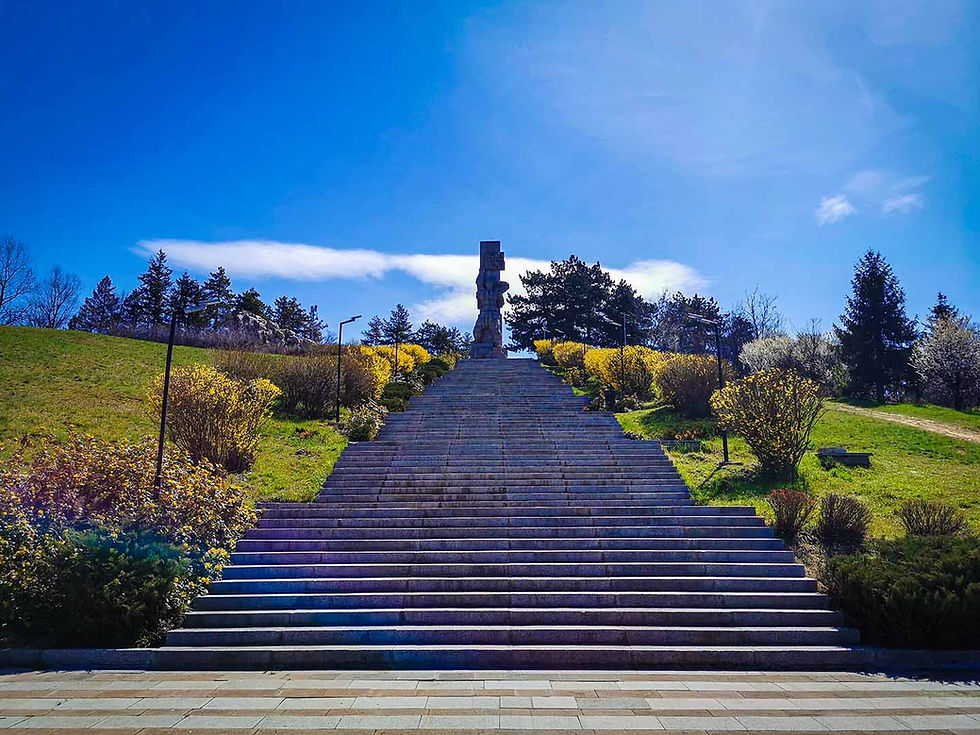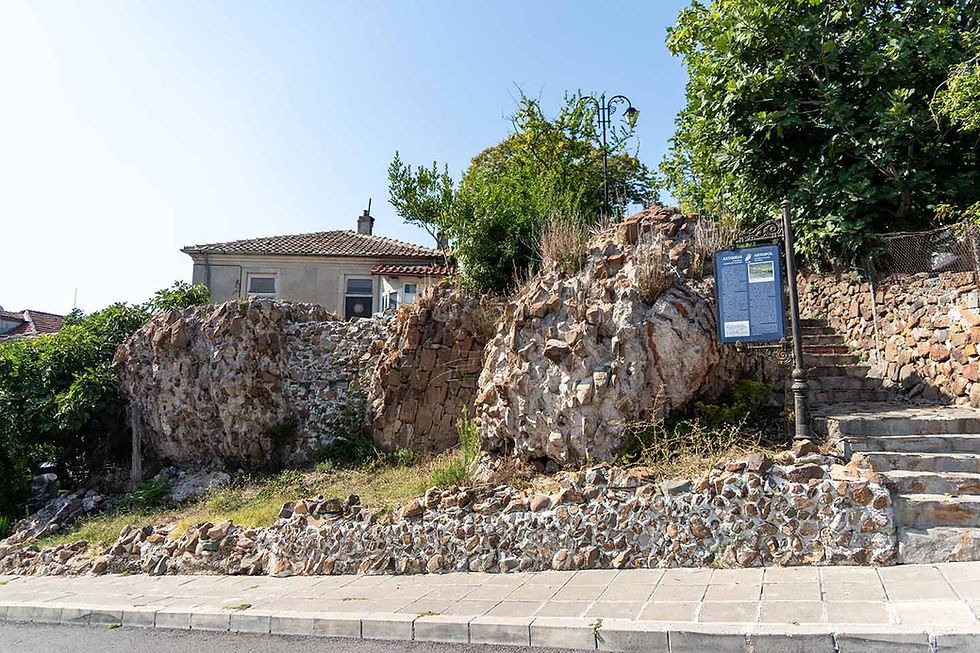Todor Kableshkov
- Stefan Ivanov

- Jan 13, 2023
- 8 min read
Updated: Jan 20, 2025
Todor Lulchov Kableshkov is a Bulgarian revolutionary, a participant in the April Uprising.

He was born in the wealthy family of Hadji Lulcho Donchov Kableshkov in Koprivshtitsa on January 13 (January 1 old style) 1851. His father is a well-to-do resident of Koprivshten, engaged in running and running errands. Although he belongs to the chorbadji, Hadji Lulcho is a patriot and patriot.

Todor is very attached to his mother Stoika and suffered her early death. He and his five brothers and sisters are taken care of by Hadji Lulcho's sister, Pena - wife of the famous Koprivsht chorabadji and outlaw Doncho Vatah. His aunt Pena, or as Todor himself calls her Mama Pena, is an educated Bulgarian woman who often tells him about her husband's many exploits. Later, his father married Anna Grigorova and Todor built a strong friendship with her, which also helped a lot to raise his spirit as a patriot and revolutionary. From an early age, he had health problems, but this never stopped him. He initially studied in his native Koprivshtitsa, where he was taught by Hariton Gruev (he later Bulgarianized his name to Veselin), brother of the great revivalist Joakim Gruev. Todor stands out as a good and diligent student.

At the end of 1864, Hadji Lulcho took Todor to Plovdiv to his younger brother Tsoko Kableshkov, who enrolled him in the prestigious main diocesan school, where he was taught by Joakim Gruev himself. There he encountered the Greekization of the city, the arrogant attitude towards the Bulgarians. More than once, disputes with other Greek students escalated into hand-to-hand combat. His hatred for the enslavers also flares up in Plovdiv, when Todor happens to pass through one of the Turkish neighborhoods. The Turks stoned him and he returned home bleeding and with a cracked skull. In response to the complaint of Tsoko Kableshkovi and Daskal Gruev to the Turkish nobles, Todor was only advised not to pass through the Turkish quarters anymore. In 1867, Todor became seriously ill and his father was forced to send him back to Koprivshtitsa, where he was taught as a private student in order to keep up with his education.
It was then that he showed his organizational abilities by founding a student society for enlightenment and knowledge "Zora". When his parents sent him to the prestigious French Sultan Lyceum Galatasaray in Constantinople, he resigned as chairman and left instructions for the further activities of the society. Tsoko Kableshkov, who needs a faithful collaborator for the growing trade, convinces Hadji Lulcho that Todor needs a more serious education, and with their mutual patronage, he becomes a student at the highly prestigious French Lycée "Mehtep Sultanie" in Galatasaray at the time. This happened in the fall of 1868 in Tsarigrad, and Kableshkov had the opportunity to join the circle of Petko R. Slaveykov, where he got acquainted for the first time with some works of Lyuben Karavelov. In the lyceum he met other Bulgarian students, among them Pavel Bobekov from Panagyurishte and Konstantin Velichkov from Tatar Pazardzhik. Together with them, he read an old and tattered copy of Rakovski's "Forest Traveler", which was then considered rebellious literature. In the lyceum, Todor encountered the Greekism he knew from Plovdiv, and it was after a fight with Greeks that he gave up his name Todor (which is of Greek origin) and insisted on being addressed as the Bulgarian Bogdan.
In 1871, Todor returned to his native Koprivshtitsa. It is from that time that his first revolutionary manifestations date. He is friends with the shoemaker Petko Todorov Boyadzhiev-Kundurdzhiyat and the teacher Nayden Popstoyanov. On May 25, 1871, Daskal Popstoyanov founded the women's society "Blagovesthenie", of which Kableshkov's mother became the president, and this allowed them to develop their revolutionary activities undisturbed. Kableshkov, although he was seriously ill at the time, also met Vasil Levski himself, who arrived in Koprivshtitsa at the end of December 1871 together with Angel Kanchev, and this had a strong influence on his further development as a revolutionary. On January 1, 1872, Kableshkov founded the company Trudolyubie - a cooperative society for the economic and cultural advancement of the people.
He went to Edirne, where he learned to work as a telegraph operator at the Edirne railway station. There he also organized his first rebellion, albeit a symbolic one. Students who are members of his circle sing "Stani, stand, Balkan hero" during the liturgy, which eventually leads to the intervention of even the police, who arrest the students, but they are later released. Having mastered the telegraph well, Kableshkov worked as a clerk-telegrapher at the station of the Baronhirsh Railway in Plovdiv. He showed enviable skills and was reassigned as a telegraph operator at the Belovo station and was soon promoted to its chief. Although his post provides him with an enviable material condition, he does not give up his work, on the contrary. Under the guise of a station master, he traveled around the villages around Belovo, trying to educate the villagers and involve them in revolutionary activity. Actively assisted in the opening of the Iskra community center in the village of Golyamo Belovo, which has become a cultural and revolutionary center in the area. From Belovo, Kableshkov maintained an active relationship with his like-minded people and took part in the preparation of the Staro Zagora uprising.
In the spring of 1875, he resigned as station master and settled in Tatar Pazardzhik (today Pazardzhik) and as a timber merchant he traveled around the cities of Sofia, Samokov, Pirot and other settlements to check the revolutionary sentiments among the Bulgarians. Assists local revolutionaries in strengthening and developing committees. In the fall of 1875, his health deteriorated again and he left for his native Koprivshtitsa. It was there that he learned about the unfortunate end of the Staro Zagora uprising, which prompted him to engage in revolutionary activities even more actively. In Koprivshtitsa he met the two teachers Maria Bocheva Bulgarova from Sopot and Evlampia Vekilova. It is they who will embroider the flag of the Koprivshten insurgents. He fell in love with Maria Bulgarova, but she left for Gabrovo, and from there he returned to teach in his native Sopot. He does not try to stop her even when they are parting and gives her a photo and scissors to use in sewing another flag, and if necessary - to cut her veins so that the Turks do not capture her.
Kableshkov often travels to Plovdiv, where he stops at Hristo G. Danov's bookstore to buy the new Bulgarian books. During his travels he visited a number of villages where he created and strengthened committees.
In the fall of 1875, after the end of the Staro Zagora Uprising, prominent revolutionary figures gathered in Giurgievo to plan a new uprising that was to break out in the spring of the following year. Among the founders of the Giurgiu Central Revolutionary Committee are Nikola Obretenov, Stoyan Zaimov, Georgi Benkovski, Stefan Stambolov, Hilarion Dragostinov, Georgi Izmirliev and others. After long discussions, they divided the Bulgarian lands into four revolutionary districts - Vrachanski, Tarnovski, Slivenski and Plovdivski, later renamed Panagyurski. It was decided that the uprising would break out on May 1. In the Fourth Revolutionary District, Panayot Volov was elected as the chief apostle, and Georgi Benkovski was appointed as his assistant.
At the beginning of January 1876, the two crossed the Danube near Oryahovo and visited Plovdiv, but soon realized that the committee network was better developed in the Trans-Balkan valleys and moved the revolutionary center to Panagyurishte. Much has already been done for the case in the settlements of Panagyurishte, Klisura, Bratsigovo, Peshtera, Tatar Pazardzhik, Kalofer, Belovo and others. Here the two apostles found active helpers in the person of Kableshkov, Kocho Chistemenski, Zahari Stoyanov, Nayden Popstoyanov, Ivan Arabadzhiyat and many others.
On the evening of January 13, at the home of Tancho Shabanov in Koprivshtitsa, a second committee was formed by Panayot Volov. Nayden Popstoyanov, Tancho Shabanov, Father Nikola Belchev, Tsoko Budin, Kableshkov, Nesho Popbraikov and others took part in the meeting. The participants swear by the gospel, a knife and a revolver by Father Nicholas.
The oath read:
Заклевам се в името на всемогъщия Бог, че за славата на народа си и за честта на православната вяра ще забия петстотингодишния ръждясал български нож в гърдите на турския султан! Ако престъпя клетвата си, да бъда проклет от целия български народ и да ме постигне най-тежкото Божие наказание...
Volov gives Kableshkov a power of attorney, which proves that he is authorized to create revolutionary committees by the leadership of the uprising itself. It was signed and stamped by Volov with his fake name Petar Bankov. Kableshkov gets sick again, but that doesn't stop him.
On April 14, the meeting was held in Oborishte, where Koprivshtitsa was represented by two delegates - Nayden Popstoyanov and Todor Dushenchanina (from the village of Dushantsi), who took with them a letter from Kableshkov about Volov and Benkovski.
On April 20, 1876, after the firing of the first rifle in Koprivshtitsa, Todor Kableshkov wrote the famous bloody letter.
After the defeat of the uprising, the few remaining members of Kableshkov's squad hid in the Trojan Balkans, fleeing to Romania. After a betrayal, most are killed and Kableshkov is captured. Torture and interrogations follow. On the way to Plovdiv, when the convoy stopped for the night at the inn in Gabrovo, Kableshkov took advantage of the inattention of one of his guards, took his revolver and shot himself in the head.
The date was June 16, 1876, and Kableshkov was only 25 years old.
The next day, the bishop's vicar of Gabrovo begged Selami Pasha to give him the body for a Christian burial. The insurgent was washed, dressed in new clothes, and his body was buried near the graves of two Chetniks from Hadji Dimitar's squad, hanged in Gabrovo.
In 1883, the mortal remains of Todor Kableshkov were transported and buried in Koprivshtitsa in the Mausoleum-ossuary of Aprilians. Due to the poor conditions there, the bones of Todor and Nayden Popstoyanov were displayed for worship in his native home until 1996, when they were reburied in the courtyard of the Assumption of the Blessed Virgin Mary church.

The birth house of the revolutionary in Koprivshtitsa has been turned into a museum. Many of his belongings can be seen there, including his photos, documents, textbooks, weapons, the hat he wore while he was station chief in Belovo and others.
Dear friends, following are links to all my April Epic posts
Oborishte historical area
15 – 17 April summer 1876 and the first Bulgarian National Assembly

Georgi Benkovski

Todor Kableshkov

The bloody letter

The Tuteva House in Panagyurishte and announcement of the uprising

Birthplace of Raina Knyaginya

Church "St. Dimitar" in "Verigovo"

Sinjirli well square in Bratsigovo

Klisura

Vasil Petleshkov and fighting Bratsigovo

Church "St. Archangel Michael" - the last refuge in Peruštitsa


To be known! To be remembered!




Comments